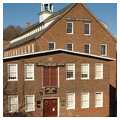You are here
American Precision Museum (Robbins and Lawrence Armory and Machine Shop)
Built for Robbins and Lawrence, a gun maker and machine-tool company, this outstanding example of Windsor's early manufacturing history stands along the banks of Mill Brook among the remains of other industrial buildings. It is an attractive, if typical, brick mill on a coursed rubble foundation. It is three-and-a-half-stories tall with a hexagonal domed belfry, large windows under granite lintels, and trapdoor monitors at the attic level to assure ample interior light. A southwest corner tower with loading doors at each level and a two-story office wing to the east (built later) are appended to the main mass.
It was in this mill that such mechanical geniuses as Richard S. Lawrence, Frederick Webster Howe, and Henry D. Stone created major innovations in machine tools, from the profiling machine to the universal milling machine. Though the company primarily manufactured guns for government contracts, the machines it invented are basic to the practices of mass production itself, with interchangeable parts and precision tooling. The company was invited to display its products at the Great Exhibition of 1851 in the Crystal Palace in London. But, despite an international reputation, it was financially over-extended and went bankrupt a few years later. A succession of owners used the building for everything from manufacturing Union Army rifles during the Civil War to milling cotton. Central Vermont Public Service Corporation acquired the property in 1926 and donated it in 1966 to the newly formed American Precision Museum. A testament to the adaptability of mid-nineteenth-century mill design, the structure is now a National Historic Landmark and a museum dedicated to the history of Vermont's machine-tool industry.
Writing Credits
If SAH Archipedia has been useful to you, please consider supporting it.
SAH Archipedia tells the story of the United States through its buildings, landscapes, and cities. This freely available resource empowers the public with authoritative knowledge that deepens their understanding and appreciation of the built environment. But the Society of Architectural Historians, which created SAH Archipedia with University of Virginia Press, needs your support to maintain the high-caliber research, writing, photography, cartography, editing, design, and programming that make SAH Archipedia a trusted online resource available to all who value the history of place, heritage tourism, and learning.


















